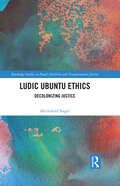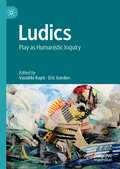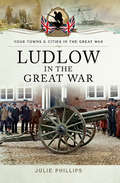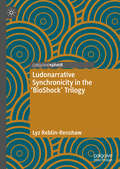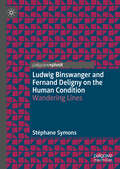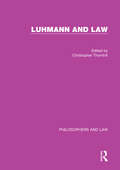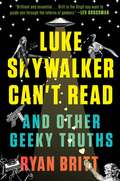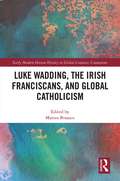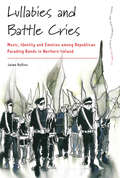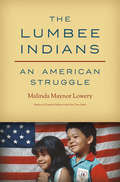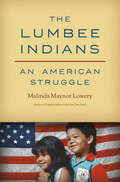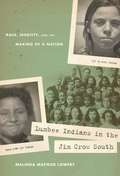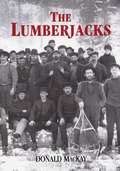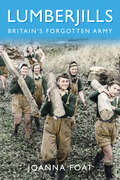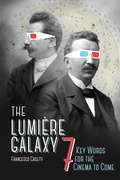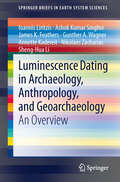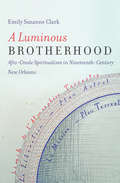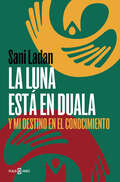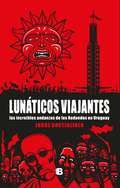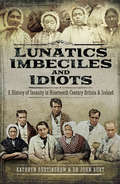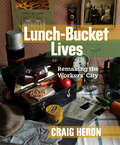- Table View
- List View
The Ludic City: Exploring the Potential of Public Spaces
by Quentin StevensThis international and illustrated work challenges current writings focussing on the problems of urban public space to present a more nuanced and dialectical conception of urban life. Detailed and extensive international urban case studies show how urban open spaces are used for play, which is defined and discussed using Caillois' four-part definition – competition, chance, simulation and vertigo. Stevens explores and analyzes these case studies according to locations where play has been observed: paths, intersections, thresholds, boundaries and props. Applicable to a wide-range of countries and city forms, The Ludic City is a fascinating and stimulating read for all who are involved or interested in the design of urban spaces.
Ludic Ubuntu Ethics: Decolonizing Justice (Routledge Studies in Penal Abolition and Transformative Justice)
by Mechthild NagelLudic Ubuntu Ethics develops a positive peace vision, taking a bold look at African and Indigenous justice practices and proposes new relational justice models. ‘Ubuntu’ signifies shared humanity, presenting us a sociocentric perspective of life that is immensely helpful in rethinking the relation of offender and victim. In this book, Nagel introduces a new theoretical liberation model—ludic Ubuntu ethics—to showcase five different justice conceptions through a psychosocial lens, allowing for a contrasting analysis of negative Ubuntu (eg., through shaming and separation) towards positive Ubuntu (eg., mediation, healing circles, and practices that no longer rely on punishment). Providing a novel perspective on penal abolitionism, the volume draws on precolonial (pre-carceral) Indigenous justice perspectives and Black feminism, using discourse analysis and a constructivist approach to justice theory. Nagel also introduces readers to a post secular turn by taking seriously the spiritual dimensions of healing from harm and highlighting the community’s response. Spanning disciplinary boundaries and aimed at readers seeking to understand how to move beyond reintegrative shaming and restorative justice theories, the volume will engage scholars of criminology, philosophy and law, and more specifically penal abolitionism, social ethics, peace studies, African studies, critical legal studies, and human rights. It will also be of great interest to practitioners and activists in restorative justice, mediation, social work, and performance studies.
Ludics: Play as Humanistic Inquiry (Studies In Surrealism Ser.)
by Vassiliki Rapti Eric GordonThis book establishes play as a mode of humanistic inquiry with a profound effect on art, culture and society. Play is treated as a dynamic and relational modality where relationships of all kinds are forged and inquisitive interdisciplinary engagement is embraced. Play cultivates reflection, connection, and creativity, offering new epistemological directions for the humanities. With examples from a range of disciplines including poetry, history, science, religion and media, this book treats play as an object of inquiry, but also as a mode of inquiry. The chapters, each focusing on a specific cultural phenomenon, do not simply put culture on display, they put culture in play, providing a playful lens through which to see the world. The reader is encouraged to read the chapters in this book out of order, allowing constructive collision between ideas, moments in history, and theoretical perspectives. The act of reading this book, like the project of the humanities itself, should be emergent, generative, and playful.
Ludlow in the Great War (Your Towns & Cities in the Great War)
by Julie PhillipsWars affect everyone. Whether they are fought on the battlefields or on the home front, by the armed forces or civilians, sacrifices have to be made, and everyone suffers one way or another. This book gives a flavour of what it was like to live in Ludlow through the Great War years. Ludlow was proud to send its brothers, husbands, uncles and fathers to fight for King and Country, many of whom had never been far from home before, some who came from decorated service backgrounds for whom the armed services was in their blood. Rich or poor, farm worker, office manager or son of a wealthy estate owner, they all united to defend their town and protect British values and way of life. Life continued as usual for many of those on the home front despite, amongst other things, the introduction of DORA, rationing and the loss of the labour force from the farms. Ludlow was already generous in its giving to the poor but this was taken to a whole new level with the introduction of many national and local war charities. They knitted, sewed, auctioned and sung their way through the war even a patriotic donkey called Willie and a pig did their bit by being auctioned several times to raise money for the war effort.This show of patriotism and stoicism was made against the backdrop of a bloody and heinous war that went on far longer than anticipated. The constant threat of receiving the dreaded telegram indicating their loved ones fate was never far from the minds of Ludlow's civilians, yet the people of Ludlow kept the home fires burning brightly.
Ludonarrative Synchronicity in the 'BioShock' Trilogy
by Lyz Reblin-RenshawThis book presents a new methodology, ludonarrative synchronicity, to analyze the interplay between narrative and gameplay in video games. Using the BioShock franchise as a case study, this book aims to show the interaction of these two elements can form various subjects. Rather than prioritizing one over the other, ludonarrative synchronicity seeks to explore how video game texts function. By analyzing a trio of games focused on choice and control, this book manages to show how players, along with developers, can create their own subjects. Ludonarrative Synchronicity in the BioShock Trilogy will appeal not only to fans of the franchise, but to students and scholars of narrative theory, game design, and posthumanism.
Ludwig Binswanger and Fernand Deligny on the Human Condition: Wandering Lines
by Stéphane SymonsPhilosophical thinking allows itself to be nourished by seemingly non-committal exercises of thought but at the same time seeks forms of irrefutable knowledge. Because of this focus on both the subjective and the universal, philosophy also falls for the lure of the “what-if?” question. What if two legendary artists, writers or philosophers, who did not know each other, did enter into a conversation? In this book, Stéphane Symons outlines an (im)possible conversation between Swiss psychiatrist and philosopher Ludwig Binswanger (1881-1966) and French educator, philosopher, poet and filmmaker Fernand Deligny (1913-1996). Although the two never met, this imaginary conversation can offer insight into both authors' thinking and the human condition. According to Binswanger, self-awareness and social consciousness are the most important and characteristic features of human beings. In contrast, from his contacts with children and adolescents with autism, Deligny emphasizes our ability to interact with the material environment, especially with seemingly insignificant things and nature. Bringing the two thinkers into conversation, Symons sheds new light on what it is to be truly human. In the process, leading roles are played by one of Binswanger's patients, Ellen West, and a young boy with autism, Janmari.
Luhmann and Law (Philosophers And Law Ser.)
by Christopher ThornhillNiklas Luhmann wrote a number of works which have decisively shaped the recent development of legal science as a theoretical discipline. Some basic elements of his theory have been widely appropriated by other legal theorists, such that it is difficult to imagine contemporary reflection in legal theory, and above all legal sociology, without Luhmann. This collection brings together the most important canonical and cutting-edge papers on Luhmann’s legal thought. It is introduced in a comprehensive editorial piece by the editor which locates the articles in context and explores the issues and topics at hand.
Luke Skywalker Can't Read: And Other Geeky Truths
by Ryan Britt"Ryan Britt is . . . the Virgil you want to guide you through the inferno of geekery." --Lev Grossman, author of the bestselling Magician's trilogy Pop Culture and sci-fi guru Ryan Britt has never met a monster, alien, wizard, or superhero that didn't need further analysis. Essayist Ryan Britt got a sex education from dirty pictures of dinosaurs, made out with Jar-Jar Binks at midnight, and figured out how to kick depression with a Doctor Who Netflix-binge. Alternating between personal anecdote, hilarious insight, and smart analysis, Luke Skywalker Can't Read contends that Barbarella is good for you, that monster movies are just romantic comedies with commitment issues, that Dracula and Sherlock Holmes are total hipsters, and, most shockingly, shows how virtually everyone in the Star Wars universe is functionally illiterate. Romp through time and space, from the circus sideshows of 100 years ago to the Comic Cons of today, from darkest corners of the Galaxy to the comfort of your couch. For anyone who pretended their flashlight was a lightsaber, stood in line for a movie at midnight, or dreamed they were abducted by aliens, Luke Skywalker Can't Read is full of answers to questions you haven't thought to ask, and perfect for readers of Chuck Klosterman, Rob Sheffield, and Ernest Cline.From the Trade Paperback edition.
Luke Wadding, the Irish Franciscans, and Global Catholicism (Early Modern Iberian History in Global Contexts)
by Matteo BinascoThis book explores the endeavors and activities of one of the most prominent early modern Irishmen in exile, the Franciscan Luke Wadding. Born in Ireland, educated in the Iberian Peninsula, Wadding arrived in Rome in 1618, where he would die in 1657. In the "Eternal City," the Franciscan emerged as an outstanding theologian, a learned scholar, a diplomat, and a college founder. This innovative collection of chapters brings together a group of international scholars who provide a ground-breaking analysis of the many cultural, political, and religious facets of Wadding&’s life. They illustrate the challenges and changes faced by an Irishman who emerged as one of the most outstanding global figures of the Catholic Reformation. The volume will attract scholars of the early modern period, early modern Catholicism, and Irish emigration.
Lullabies and Battle Cries: Music, Identity and Emotion among Republican Parading Bands in Northern Ireland (Dance and Performance Studies #13)
by Jaime RollinsSet against a volatile political landscape, Irish republican culture has struggled to maintain continuity with the past, affirm legitimacy in the present, and generate a sense of community for the future. Lullabies and Battle Cries explores the relationship between music, emotion, memory, and identity in republican parading bands, with a focus on how this music continues to be utilized in a post-conflict climate. As author Jaime Rollins shows, rebel parade music provides a foundational idiom of national and republican expression, acting as a critical medium for shaping new political identities within continually shifting dynamics of republican culture.
The Lumbee Indians: An American Struggle
by Malinda Maynor LoweryJamestown, the Lost Colony of Roanoke, and Plymouth Rock are central to America's mythic origin stories. Then, we are told, the main characters--the "friendly" Native Americans who met the settlers--disappeared. But the history of the Lumbee Tribe of North Carolina demands that we tell a different story. As the largest tribe east of the Mississippi and one of the largest in the country, the Lumbees have survived in their original homelands, maintaining a distinct identity as Indians in a biracial South. In this passionately written, sweeping work of history, Malinda Maynor Lowery narrates the Lumbees' extraordinary story as never before. The Lumbees' journey as a people sheds new light on America's defining moments, from the first encounters with Europeans to the present day. How and why did the Lumbees both fight to establish the United States and resist the encroachments of its government? How have they not just survived, but thrived, through Civil War, Jim Crow, the civil rights movement, and the war on drugs, to ultimately establish their own constitutional government in the twenty-first century? Their fight for full federal acknowledgment continues to this day, while the Lumbee people's struggle for justice and self-determination continues to transform our view of the American experience. Readers of this book will never see Native American history the same way.
The Lumbee Indians: An American Struggle
by Malinda Maynor LoweryJamestown, the Lost Colony of Roanoke, and Plymouth Rock are central to America's mythic origin stories. Then, we are told, the main characters--the "friendly" Native Americans who met the settlers--disappeared. But the history of the Lumbee Tribe of North Carolina demands that we tell a different story. As the largest tribe east of the Mississippi and one of the largest in the country, the Lumbees have survived in their original homelands, maintaining a distinct identity as Indians in a biracial South. In this passionately written, sweeping work of history, Malinda Maynor Lowery narrates the Lumbees' extraordinary story as never before. The Lumbees' journey as a people sheds new light on America's defining moments, from the first encounters with Europeans to the present day. How and why did the Lumbees both fight to establish the United States and resist the encroachments of its government? How have they not just survived, but thrived, through Civil War, Jim Crow, the civil rights movement, and the war on drugs, to ultimately establish their own constitutional government in the twenty-first century? Their fight for full federal acknowledgment continues to this day, while the Lumbee people's struggle for justice and self-determination continues to transform our view of the American experience. Readers of this book will never see Native American history the same way.
Lumbee Indians in the Jim Crow South
by Malinda Maynor LoweryWith more than 50,000 enrolled members, North Carolina's Lumbee Indians are the largest Native American tribe east of the Mississippi River. Malinda Maynor Lowery, a Lumbee herself, describes how, between Reconstruction and the 1950s, the Lumbee crafted and maintained a distinct identity in an era defined by racial segregation in the South and paternalistic policies for Indians throughout the nation. They did so against the backdrop of some of the central issues in American history, including race, class, politics, and citizenship.Lowery argues that "Indian" is a dynamic identity that, for outsiders, sometimes hinged on the presence of "Indian blood" (for federal New Deal policy makers) and sometimes on the absence of "black blood" (for southern white segregationists). Lumbee people themselves have constructed their identity in layers that tie together kin and place, race and class, tribe and nation; however, Indians have not always agreed on how to weave this fabric into a whole. Using photographs, letters, genealogy, federal and state records, and first-person family history, Lowery narrates this compelling conversation between insiders and outsiders, demonstrating how the Lumbee People challenged the boundaries of Indian, southern, and American identities.
The Lumberjacks
by Donald MackayShort-listed for the 1978 Governor General’s Award for Non-Fiction The 19th century spawned a unique breed of men who took pride in their woodsmen skills and rough codes of conduct. They called themselves lumberers, shantymen, timber beasts, les bucherons – and, more recently, lumberjacks, working in the vast forests of eastern Canada and British Columbia. Across the country, farm boys would go to the woods, lumbering being the only winter work available. Immigrants – Swedes and Finns more often than not – resumed the trades they had learned so well in the forests of northern Europe. They broke the cold, hard monotony of camp life with songs, tall tales and card games. Within these pages, author Donald MacKay allows us a glimpse into that moment in our heritage when men entered the virgin forest to carve out an industry from the seemingly endless array of pine, spruce, maple and balsam fir found there.
Lumberjills: Britain's Forgotten Army
by Joanna FoatWhen war was declared in 1939, Britain was almost completely dependent on imported timber – but only had seven months of it stockpiled. Timber was critical to the war effort: it was needed for everything from aircraft and shipbuilding to communications and coal mining. The British timber trade was in trouble. Enter the Lumberjills. Lacking in both men and timber, the government made a choice. Reluctantly, they opened lumber work for women to apply – and apply they did. The Women’s Timber Corps had thousands of members who would prove themselves as strong and as smart as any man: they felled and crosscut trees by hand, operated sawmills, and ran whole forestry sites. They may not have been on the front line, but they fought their own battles on the home front for respect and equality. And in the midst of heavy labour and wartime, they lived a life, making firm friends and even finding soulmates. In Lumberjills, researcher Joanna Foat tells their story for the first time, and gives them the recognition they so truly deserve.
The Lumière Galaxy
by Francesco CasettiFrancesco Casetti believes new media technologies are producing an exciting new era in cinema aesthetics. Whether we experience film in the theater, on our hand-held devices, in galleries and museums, onboard and in flight, or up in the clouds in the bits we download, cinema continues to alter our habits and excite our imaginations.Casetti travels from the remote corners of film history and theory to the most surprising sites on the internet and in our cities to prove the ongoing relevance of cinema. He does away with traditional notions of canon, repetition, apparatus, and spectatorship in favor of new keywords, including expansion, relocation, assemblage, and performance. The result is an innovative understanding of cinema's place in our lives and culture, along with a critical sea-change in the study of the art. The more the nature of cinema transforms, the more it discovers its own identity, and Casetti helps readers realize the galaxy of possibilities embedded in the medium.
The Lumière Galaxy: Seven Key Words for the Cinema to Come (Film and Culture Series)
by Francesco CasettiFrancesco Casetti believes new media technologies are producing an exciting new era in cinema aesthetics. Whether we experience film in the theater, on our hand-held devices, in galleries and museums, onboard and in flight, or up in the clouds in the bits we download, cinema continues to alter our habits and excite our imaginations. Casetti travels from the remote corners of film history and theory to the most surprising sites on the internet and in our cities to prove the ongoing relevance of cinema. He does away with traditional notions of canon, repetition, apparatus, and spectatorship in favor of new keywords, including expansion, relocation, assemblage, and performance. The result is an innovative understanding of cinema's place in our lives and culture, along with a critical sea-change in the study of the art. The more the nature of cinema transforms, the more it discovers its own identity, and Casetti helps readers realize the galaxy of possibilities embedded in the medium.
Luminescence Dating in Archaeology, Anthropology, and Geoarchaeology: An Overview
by Annette Kadereit Ioannis Liritzis Sheng-Hua Li Rudolf Wagner Jim Feathers Nikolaos Zacharias Ashok SinghviThe field of Luminescence Dating has reached a level of maturity. Both research and applications from all fields of archaeological science, from archaeological materials to anthropology and geoarchaeology, now routinely employ luminescence dating. The advent of optically stimulated luminescence (OSL) techniques and the potential for exploring a spectrum of grain aliquots enhanced the applicability, accuracy and the precision of luminescence dating. The present contribution reviews the physical basis, mechanisms and methodological aspects of luminescence dating; discusses advances in instrumentations and facilities, improvements in analytical procedures, and statistical treatment of data along with some examples of applications across continents, covering all periods (Middle Palaeolithic to Medieval) and both Old and New World archaeology. They also include interdisciplinary applications that contribute to palaeo-landscape reconstruction.
A Luminous Brotherhood: Afro-Creole Spiritualism in Nineteenth-Century New Orleans
by Emily Suzanne ClarkIn the midst of a nineteenth-century boom in spiritual experimentation, the Cercle Harmonique, a remarkable group of African-descended men, practiced Spiritualism in heavily Catholic New Orleans from just before the Civil War to the end of Reconstruction. In this first comprehensive history of the Cercle, Emily Suzanne Clark illuminates how highly diverse religious practices wind in significant ways through American life, culture, and history. Clark shows that the beliefs and practices of Spiritualism helped Afro-Creoles mediate the political and social changes in New Orleans, as free blacks suffered increasingly restrictive laws and then met with violent resistance to suffrage and racial equality. Drawing on fascinating records of actual seance practices, the lives of the mediums, and larger citywide and national contexts, Clark reveals how the messages that the Cercle received from the spirit world offered its members rich religious experiences as well as a forum for political activism inspired by republican ideals. Messages from departed souls including Francois Rabelais, Abraham Lincoln, John Brown, Robert E. Lee, Emanuel Swedenborg, and even Confucius discussed government structures, the moral progress of humanity, and equality. The Afro-Creole Spiritualists were encouraged to continue struggling for justice in a new world where "bright" spirits would replace raced bodies.
La luna está en Duala: Y mi destino en el conocimiento
by Sani LadanLa conmovedora historia real de un adolescente que cruzó todo un continente para seguir estudiando. Imagina que vives en un país que no te permite realizar los estudios necesarios para desarrollarte como individuo. Imagina que no tienes mayor sueño que ese, precisamente. Trata de imaginar ahora que, con quince años, con la mente fría y despierta del adulto que proyectas ser y el corazón cargado de los secretos e ilusiones del niño que eres todavía, te escapas de casa sin más fin que conseguir un propósito que comienza a truncarse y a volverse violento y deshumanizante desde la primera parada en el camino. Esta historia, tan real como lo es la injusticia en el mundo en que vivimos, es la mía. «Me recuerdo tumbado, mirando al cielo. Incluso en esas circunstancias era imposible no apreciar la belleza de las estrellas y de la luna llena en un cielo tan limpio y despejado. Por mi mente desfilaban las imágenes de cada miembro de mi familia, de cada amigo. Conecté de nuevo con mi realidad, que había dejado atrás cuando vivimos el ataque de Boko Haram en Nigeria. En ese preciso momento quise tirar la toalla, volver a casa y reunirme con mis padres, pero lo cierto era que estaba en un lugar donde, por mucho que gritara, nadie me escucharía, salvo los que estaban conmigo, igual o peor que yo. Entonces me acordé de que a mi madre le encantaba contemplar la luna, sobre todo cuando está llena. En casa se ponía, a veces, un cubo con agua en el patio para observar el reflejo que la luna dejaba en su interior. Pensé que, en ese instante, mi madre podría estar contemplando la misma luna que yo, pero en casa, en Duala. Así que me puse a hablar con ella, o al menos eso creía, a través de la luna».
Lunatic Asylums in Colonial Bombay: Shackled Bodies, Unchained Minds (Mental Health in Historical Perspective)
by Sarah Ann PintoThis book traces the historical roots of the problems in India’s mental health care system. It accounts for indigenous experiences of the lunatic asylum in the Bombay Presidency (1793-1921). The book argues that the colonial lunatic asylum failed to assimilate into Indian society and therefore remained a failed colonial-medical enterprise. It begins by assessing the implications of lunatic asylums on indigenous knowledge and healing traditions. It then examines the lunatic asylum as a ‘middle-ground’, and the European superintendents’ ‘common-sense’ treatment of Indian insanity. Furthermore, it analyses the soundscapes of Bombay’s asylums, and the extent to which public perceptions influenced their use. Lunatic asylums left a legacy of historical trauma for the indigenous community because of their coercive and custodial character. This book aims to disrupt that legacy of trauma and to enable new narratives in mental health treatment in India.
Lunáticos viajantes: Las increíbles andanzas de Los Redondos en Uruguay
by Jorge CostiglioloA 20 años de su último recital en Montevideo conoceremos la historia, anécdotas y protagonistas de una relación de amor, pasión y rock and roll. Desde su nacimiento a fines de los años 70 en la de La Plata Patricio Rey y sus redonditos de ricota se convirtieron en un fenómeno cultural casi exclusivo de Argentina, salvo por Uruguay. Este libro repasa a través de testimonios, historias, anécdotas, mitos, verdades y leyendas las veces de cómo, cuándo y de qué manera Los Redondos se vincularon con Uruguay.
Lunatics, Imbeciles and Idiots: A History of Insanity in Nineteenth-Century Britain and Ireland
by Kathryn Burtinshaw Dr. John Burt&“Reveals the grisly conditions in which the mentally ill were kept . . . [and] harrowing details of the inhumane and gruesome treatment of these patients.&”—Daily Mail In the first half of the nineteenth century, treatment of the mentally ill in Britain and Ireland underwent radical change. No longer manacled, chained and treated like wild animals, patient care was defined in law and medical understanding, and treatment of insanity developed. Focusing on selected cases, this new study enables the reader to understand how progressively advancing attitudes and expectations affected decisions, leading to better legislation and medical practice throughout the century. Specific mental health conditions are discussed in detail and the treatments patients received are analyzed in an expert way. A clear view of why institutional asylums were established, their ethos for the treatment of patients, and how they were run as palaces rather than prisons giving moral therapy to those affected becomes apparent. The changing ways in which patients were treated, and altered societal views to the incarceration of the mentally ill, are explored. The book is thoroughly illustrated and contains images of patients and asylum staff never previously published, as well as first-hand accounts of life in a nineteenth-century asylum from a patient&’s perspective. Written for genealogists as well as historians, this book contains clear information concerning access to asylum records and other relevant primary sources and how to interpret their contents in a meaningful way. &“Through the use of case studies, this book adds a personal note to the historiography in a way that is often missing from scholarly works.&”—Federation of Family History Societies
Lunch-Bucket Lives: Remaking the Workers’ City
by Craig HeronLunch-Bucket Lives takes the reader on a bumpy ride through the history of Hamilton’s working people from the 1890s to the 1930s. It ambles along city streets, peers through kitchen doors and factory windows, marches up the steps of churches and fraternal halls, slips into saloons and dance halls, pauses to hear political speeches, and, above all, listens for the stories of men, women, youths, and children from families where people relied mainly on wages to survive. Heron takes wage-earning as a central element in working-class life, but also looks beyond the workplace into the households and neighbourhoods—settlement patterns and housing, marriage, child care, domestic labour, public health, schooling, charity and social work, popular culture, gender identities, ethnicity and ethnic conflict, and politics in various forms—presenting a comprehensive view of working-class life in the first half of the twentieth century. This book has been published with the help of a grant from the Federation for the Humanities and Social Sciences, through the Awards to Scholarly Publications Program, using funds provided by the Social Sciences and Humanities Research Council of Canada.
Lunch with the FT: A Second Helping
by Lionel BarberLunch with the FT has been a permanent fixture in the Financial Times for almost 30 years, featuring presidents, film stars, musical icons and business leaders from around the world.The column is now a well-established institution, which has reinvigorated the art of conversation in the convivial, intimate environment of a long and boozy lunch.This new and updated edition includes lunches with:Elon MuskDonald TrumpHilary MantelRichard BransonZadie SmithNigel FarageRussell BrandDavid GuettaYanis VaroufakisJean-Claude JunckerGwyneth PaltrowRebecca SolnitJordan PetersonChimamanda Ngozi AdichieAnd more...

